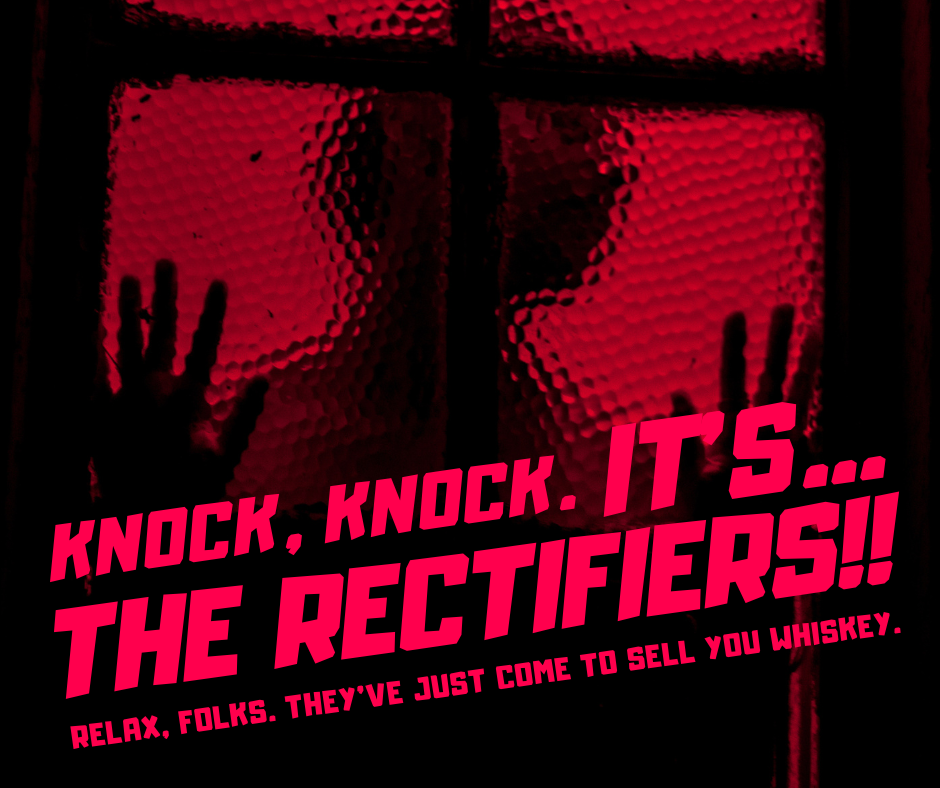One of the more confused topics when we talk about the history of the American whiskey world is the topic of rectifiers. I really wish there was a way to talk about rectifiers without the weird stigma behind the word “RECTIFIER.” So let’s try to simplify things.
Before Prohibition, how did Americans buy whiskey? They couldn’t go to the liquor store the way we do today. There was no three-tier system in place. So how did it work? Distilleries still made whiskey, of course, but there were no tasting rooms or tours. Distillers essentially became manufacturers and wholesalers after 1867 because that was the year they were stripped of the ability to sell retail on premises. They packaged their whiskey in barrels and shipped those barrels (sometimes repackaging spirits into smaller barrels for sale to hotels, restaurants, etc.) by boat or railroad (or truck/cart for local deliveries) to their wholesale buyers/customers. In many cases, the only people distilleries were doing wholesale liquor business with were RECTIFIERS. This became a very successful business relationship because rectifiers did all the hard work of bottling, distributing, advertising, and selling to the public. Some rectifiers served as middlemen- smaller distillery locations, usually within cities, whose only business was redistilling another distiller’s high wine products and selling them wholesale as neutral grain spirits or industrial alcohol. But most rectifying licenses were issued to men whose business involved buying barrels of whiskey in bulk from a distillery and repackaging that whiskey into bottles. They may have added flavoring to alter the spirit or just blended the pure spirits in-house. They were the guys with the retail locations. They put their own labels on their own bottles that they purchased from a wide variety of bottle manufacturers. This is why you might see a modern, recognizable brand on a pre-pro bottle with an unrelated person or company’s name on the bottom of the label that we don’t normally associate with that brand. Or you might see a distillery’s name on the bottom, but a different city listed than the one where the distillery was/is located. The whiskey in the latter example was bottled and sold (and likely even aged) at one of many satellite locations- all part of their distribution network- for that company.
Many liquor companies had different licenses for different aspects of their business- a distilling license for their distilling plant out in the sticks, a rectifying license for their own aging/blending/compounding warehouse in an isolated, more industrial part of town, and a retail license for their brick-and-mortar liquor store in a prime location downtown. These licenses became necessary after 1887 when the “Brooks Law” effectively separated the retailers from the wholesalers, requiring separate licenses for each. Many companies had extensive business networks with multiple locations and many licenses in the many states they did business. But their downtown retail store location did not look like today’s liquor stores where you can get any of the whiskeys that the modern distribution networks give sellers access to. These shops sold whatever the retailer purchased for sale at their location. They may have imported beers, wines, and spirits to sell on shelves beside their own, in-house specialty items. Selling liquor at retail was a highly competitive business, and certain cities became known for their unique and competitive business atmospheres. You can plainly see how important these businesses were to the growing liquor industry…and how lucrative it could be for an individual that rose above his competition. You can also see why poisoning their customers was not in their interest.
In some cases, rectifiers became so successful in their business of bottling and selling liquor that they needed more access to whiskey. Without the means to manufacture their own products, they either purchased distilleries or built their own. This trend became more common in the late 1800s when the Whiskey Trust was putting pressure on rectifiers by attempting to control and manipulate prices. Staying relevant often meant forming associations and holding conventions to find solutions together. This is a large reason why you start getting common terminology and consistency throughout the industry. Industry leaders acted as board members of these associations, and they drove the industry norms and influenced the government through their lobbying groups. Power in liquor did not come from the distillers- it was coming from the rectifiers. So you can see why these liquor men were dangerous competitors. The more power consolidated, the more the big fish wanted the little fish gone. And the best way to do that was to chip away at their competition. Think about it. Rectifiers were the bottlers. They were the direct connection to the consumers. They were the ones with the distribution networks. So if you can consolidate all that power, you can win the game. And in the late 1800s, when nearly half of the nation’s income was coming from liquor taxes, you can see how much money was involved. The government was becoming so intermingled with liquor money that we start seeing things like the Whiskey Ring scandal in the 1870s. The Whiskey Trust reforms into a corporation in the 1890s and power consolidated in New York and Peoria and other big cities. You can start to see why liquor interests would benefit by ridding themselves of rectifiers. Prohibition was the death knell for rectifiers because the sale and manufacture of liquor- basically their business’ bread and butter- was outlawed.
So before we keep spreading the propaganda of the late 1800s and early 1900s that smeared rectifiers as poisoners of the public and painting them as the guys that were creating undrinkable industrially produced alcohol, let’s try to remember that rectifiers were much more than just compounders of whiskey. They were the ones that built the liquor industry.

